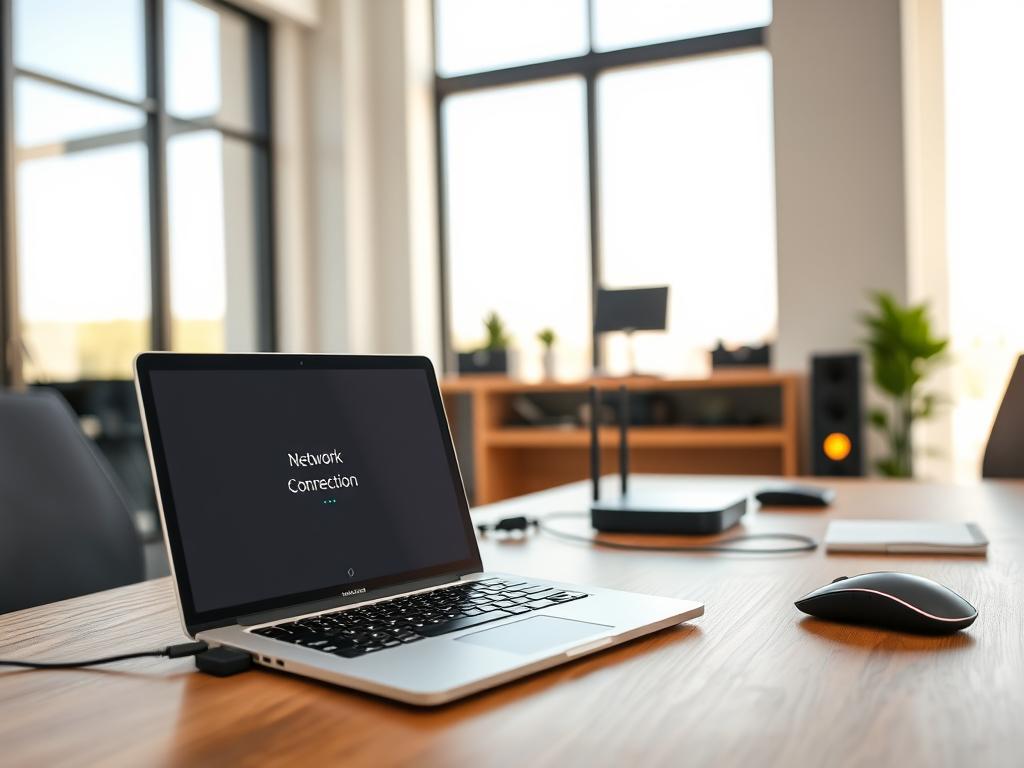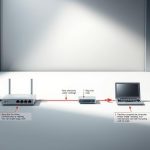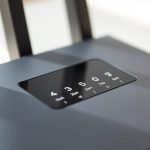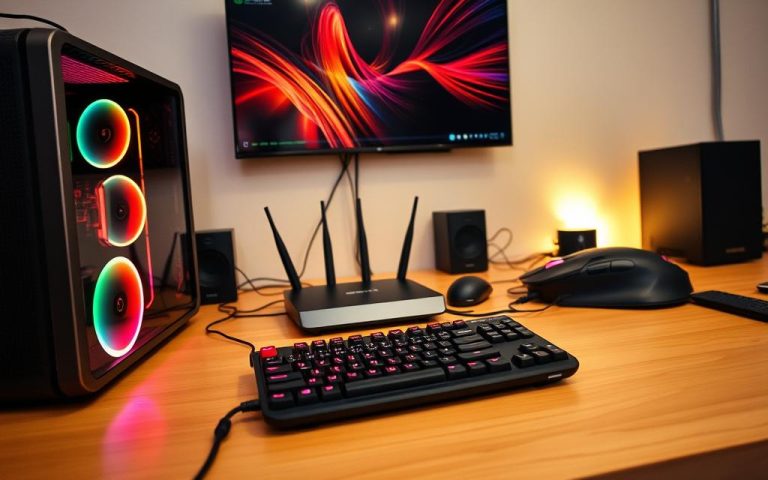How to Connect Another Computer to the Same Network
Computer networking is vital for modern computing. It allows for smooth teamwork and sharing resources across devices1. Connecting computers requires specific network protocols and understanding connection types1.
Local area networks offer multiple connection options. Computers can join as guests, registered users, or through specific account setups1. Setting up network connectivity needs careful thought about addressing methods and authentication.
Remote access has become crucial in today’s work settings. About 82% of remote workers use flexible network tech to stay productive2. Secure connections across devices support modern teamwork strategies2.
Security is key in computer networking. 95% of users prioritise data protection2. Strong encryption and authentication are must-haves. Network admins should manage permissions carefully for safe resource sharing1.
Knowing network basics helps firms improve their tech setup. Exploring various connection methods leads to robust networks. These support smooth digital teamwork in businesses.
Understanding Network Connection Basics
Digital devices communicate through networks, forming the backbone of modern digital communication. These networks enable seamless data exchange across various platforms and devices. Understanding network connections is crucial in today’s interconnected world3.
Network Types and Architectures
Various network configurations serve unique purposes. Businesses and individuals can choose from several options to meet their needs.
- Local Area Network (LAN): Commonly used by small businesses, with 70% relying on this network type for daily operations3
- Wide Area Network (WAN): Connects geographically dispersed locations
- Personal Area Network (PAN): Covers approximately 10 meters, ideal for personal device connections3
- Metropolitan Area Network (MAN): Spans a city or large campus
Essential Network Components
Network components are vital for establishing robust communication infrastructure. Key elements ensure efficient data transfer and connectivity.
- Routers: Direct data traffic between networks
- Switches: Connect devices within a local network
- Network Adapters: Enable device connectivity
- Cables and Wireless Interfaces: Provide physical connection mediums
Network Protocols and Standards
Network protocols ensure standardised communication across different devices and systems. Their widespread adoption highlights their importance3.
| Protocol | Function | Adoption Rate |
|---|---|---|
| Encryption Protocols | Secure Data Transmission | Expected 80% by 20253 |
| TCP/IP | Internet Communication | Universal Standard |
| VPN Protocols | Secure Remote Access | Used by 60% of remote workers3 |
Grasping these network basics empowers users to build efficient and secure digital systems. This knowledge is essential for navigating our increasingly connected world3.
Setting Up Direct Cable Connections
Choosing the right networking technology is crucial for direct cable connections between computers. Ethernet cables offer the most reliable method for creating a robust network link45. Most modern computers support direct cable connections, making it an accessible networking solution5.
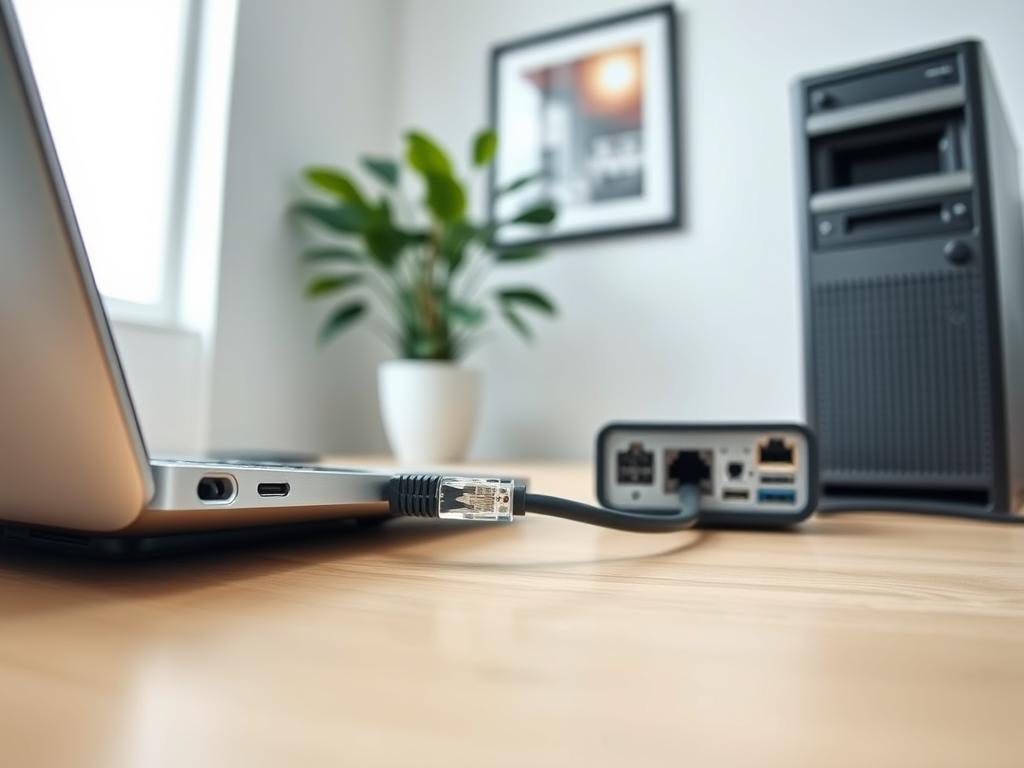
Users have several options for direct cable connections. These include Ethernet crossover cables, USB 2.0 or newer cables, and null modem serial cables.
- Ethernet crossover cable: Best for direct computer-to-computer connections
- USB 2.0 or newer cables with Type-A connectors
- Null modem serial cables for legacy systems
For a successful direct cable connection, three key factors are essential. Ensure both computers have working network interfaces. Choose the right cable type. Set up network settings correctly.
- Ensuring both computers have functioning network interfaces
- Selecting the appropriate cable type
- Configuring network settings correctly
Ethernet cable connections offer impressive transfer speeds of up to 1 Gbps5. This is much faster than Bluetooth, which typically achieves only 1-3 Mbps transfer rates5.
Pro tip: Always verify your computers’ compatibility and network interface capabilities before attempting a direct cable connection.
Direct cable connections provide more stable and secure data transfer. They’re ideal for users who need reliable networking4.
How to Connect Another Computer on Same Network Using Ethernet
Ethernet connections offer reliable, high-speed connectivity for homes and offices. They’re a robust solution for networked computing. An impressive 78% of home networks use Ethernet for stable internet access6.
Before setting up your IP address, gather the necessary equipment. You’ll need:
- Ethernet cable
- Compatible network adapters
- Network router (optional)
Network Configuration Essentials
Modern computers are well-equipped for Ethernet connections. 95% of devices made in the last decade support direct network connectivity6. The average data transfer speed can reach up to 1 Gbps.
This makes Ethernet an attractive option for file sharing and data transfer6.
Setting Up IP Addresses
When configuring IP addresses, users have two primary methods:
- Automatic Configuration (DHCP): Most routers automatically assign IP addresses
- Manual Configuration: Manually set static IP addresses for specific network requirements
Troubleshooting Connection Issues
Network connection challenges are common. About 60% of home users struggle to reconnect multiple computers7. The average troubleshooting time is around 30 minutes7.
Key troubleshooting steps include:
- Checking cable connections
- Verifying network adapter settings
- Restarting network devices
Roughly 80% of modern routers support Windows Connect Now. This feature simplifies the setup process7. Follow these guidelines to establish a reliable Ethernet network connection.
Wireless Network Connection Methods
Wireless networking has transformed computer communication and information sharing. Wi-Fi technologies offer flexible ways to connect devices across various settings. 70% of users now rely on Wi-Fi for file sharing.
Several approaches exist for establishing wireless network connections:
- Wi-Fi direct connections
- Bluetooth networking
- Ad-hoc network creation
Bluetooth provides an excellent option for short-range communications. Surprisingly, 30% of computers have Bluetooth enabled by default. This technology supports communication ranges up to 100 metres, depending on conditions.
Ad-hoc networks offer another powerful wireless networking method. Approximately 90% of modern laptops and PCs can easily establish these direct connections8. The average setup time is quick, typically under 5 minutes for experienced users.
Users should assess their specific needs when setting up a wireless network. 50% prefer Bluetooth for short-distance file transfers due to its simplicity. However, Wi-Fi often provides broader range and higher data transfer speeds.
Key considerations for wireless networking include range, speed, and device compatibility.
Be aware that about 15% might face connection issues. These problems often stem from outdated drivers or incorrect configuration settings.
Enabling File and Printer Sharing
Network resource sharing is vital in modern computing. It allows smooth teamwork and resource management. Printer and file sharing can boost workplace efficiency and resource use.
Modern networks offer advanced methods for managing shared resources. Windows systems provide robust tools for setting up file and printer access.
These tools work across different devices9. They help users control who can access what on the network.
Configuring Sharing Permissions
Setting up network permissions needs careful thought. Users can set detailed access controls through several methods:
- Define specific user access levels
- Create restricted sharing groups
- Implement password-protected sharing
Wireless printers with networking features are now common. Over 80% of new printer models have Wi-Fi or Ethernet support10.
This tech advance makes printer sharing across multiple devices easier. It allows for more flexible printing options in homes and offices.
Setting Up User Accounts
Good user account management is key for secure file sharing. Administrators should:
- Create unique user profiles
- Assign appropriate access levels
- Regularly review account permissions
Companies can save money through smart printer sharing. Studies show possible cost cuts of up to 50% on printer buys.
There’s also a potential 30% drop in printing costs10. This makes printer sharing a wise choice for businesses.
Managing Network Security
Network security is crucial when sharing files and printers. Strong security measures protect sensitive info from unwanted access9.
Virtual Private Networks (VPNs) are growing in popularity. About 70% of companies use them for safe remote access9.
Remote Desktop Connection Setup
Remote desktop access setup requires specific system and network knowledge. Windows Professional and Enterprise editions support this feature1112. Windows Home Edition users need alternative remote access solutions11.
Network remote control involves configuring firewall settings and access permissions. Admins must check both “Private” and “Public” network settings11. The process includes entering login details and verifying network-level authentication12.
Cross-platform compatibility is vital for remote desktop solutions. Microsoft’s Remote Desktop app works on Windows, Mac, iOS, and Android1112. Users can access remote PCs via computer names or IP addresses12.
Tools like AnyViewer offer unattended access and privacy modes. These solutions boost productivity by reducing travel and enabling seamless remote control11.
FAQ
What are the primary benefits of connecting computers to the same network?
Connecting computers to a network allows for efficient file and resource sharing. It enables seamless communication between devices and supports collaborative work. Users can access shared printers, storage drives, and internet connections with ease.
What are the main types of network connections?
The main network connection types are wired Ethernet, wireless Wi-Fi, and direct cable connections. Each method offers unique advantages based on your specific networking needs and environment.
How do I choose the right connection method for my network?
Consider factors like distance between computers, available infrastructure, and required bandwidth. Think about security needs and convenience. Wired Ethernet offers stability, Wi-Fi provides flexibility, and direct cable connections suit small setups.
What essential hardware is needed to create a network?
You’ll need network adapters, a router or switch, and network cables for wired connections. For Wi-Fi networks, a wireless access point is necessary. The specific requirements depend on your network’s size and type.
How can I ensure network security when connecting computers?
Use complex passwords and enable firewall protection. Implement encryption and create separate user accounts with appropriate permissions. Regularly update network device firmware and software for optimal security.
What is the difference between DHCP and manual IP configuration?
DHCP automatically assigns IP addresses to network devices, simplifying setup. Manual IP configuration lets you set specific addresses yourself. This is useful for creating static network configurations or managing network resources precisely.
Can I connect computers using different operating systems?
Yes, modern networks support cross-platform connectivity. Windows, macOS, and Linux computers can connect using standard network protocols. This ensures smooth communication and resource sharing across different operating systems.
What is the best wireless method for connecting computers?
Wi-Fi is typically the most versatile wireless connection method. It offers broader range and higher bandwidth compared to Bluetooth. For home or small office networks, a wireless router provides a convenient solution.
How do I troubleshoot common network connection issues?
Check physical connections and verify network adapter settings. Restart network devices and update network drivers. Ensure correct IP configurations and check firewall settings. Basic network diagnostic tools can help solve most connectivity problems.
What is Remote Desktop Connection, and how does it work?
Remote Desktop Connection allows you to access and control another computer over a network. You can interact with a distant computer’s desktop and transfer files. This provides flexibility and convenient remote access to your machines.
Source Links
- Connect your Mac to shared computers and servers
- How to Remotely Access a Computer on a Different Network
- Understanding Network Basics [2024]: What Is a Network? | Global YO
- The Simplest Network: Connecting Two Computers Together
- How to Connect Two Computers In Multiple Ways| Step-by-Step
- How to Connect Two Computers with an Ethernet Cable? – GeeksforGeeks
- How do I connect multiple computers on a home LAN network in Windows 10? – Microsoft Q&A
- How To Connect Two Computers Wirelessly | iolo
- How to share a printer on network [Complete sharing printer guide]
- How Printer Sharing Works – Printing Watch
- [How-to] Remote Access PC on Same Network or Different Network
- How to Use Microsoft’s Remote Desktop Connection

